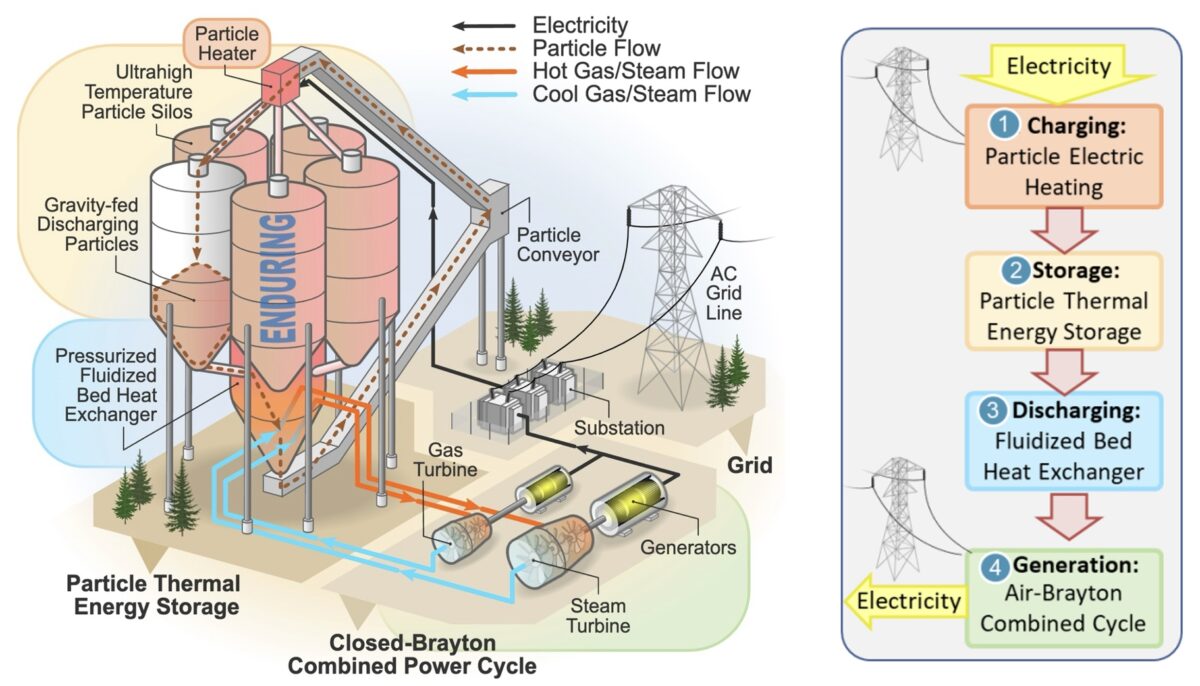|
Leakage is a problem with the losses, but apparently hydrogen leakage may also have adverse effects in the environment. I think we need to figure out how big of a problem this really is before expanding hydrogen economy. Risk of the hydrogen economy for atmospheric methane
|
|
|
|

|
| # ? Apr 27, 2024 06:09 |
|
Endjinneer posted:What form does this storage take? I was under the impression that hydrogen is a fucker to store. Salt caverns, mostly. IIRC there have also been some ideas of using depleted natural gas reservoirs or aquifers, but actual engineers really hate the idea because inspecting/qualifying one for H storage is a nightmare and storage conditions are unstable due to not fully predictable chemical and biological reactions with the hydrogen. They can also just straight up leak hydrogen. Their only advantage is the lower cost. Salt caverns on the other hand are nice, controlled environments with leakage only being a problem through technical equipment like seals/pipes/etc., which is much easier to control and track. Many countries also have an extensive network of caverns for natural gas storage already and you only need to upgrade the technical equipment to use them for hydrogen. One draw back of underground storage is that it's hard to store high purity hydrogen(like the one you need for fuel cells). There are biological and chemical reactions going on that change the gas composition. That's why the idea of just burning the stored hydrogen in thermally coupled gas plants is so attractive. The purity doesn't matter much when burning it. There have been some very promising test installations using special cavern wall coatings that, together with regular cycling, can keep high purity though. It's probably gonna be important for use cases where you do need to use fuel cells like ships or airplanes.
|
|
|
|
Endjinneer posted:What form does this storage take? I was under the impression that hydrogen is a fucker to store. Leakage scales with surface area, amount stored with volume. Leakage is a big problem at small scales (as in, hydrogen economy where everyone drives around in hydrogen-powered cars), but for grid storage you just scale the storage vessel arbitrarily large until leakage as a proportion is small enough you don't need to care about it.
|
|
|
|
Shooting Blanks posted:Someone may have asked this previously and I missed it, but can you expand on this? I feel like I've been hearing about great new battery technology that's just around the corner for the past 10 years - is this real, or is it more vaporware? You can buy sodium ion 18650's on Aliexpress now, and they're pretty cheap already. One thing I think might become an issue though with battery storage and solar/wind is maintaining the grid frequency. As far as I can tell the best way of doing that is just lots and lots of rotating mass. The Swedish railway has its own grid because it uses 15 kV AC with the wacky frequency 16⅔ Hz (one third of the standard grid frequency of 50 Hz, for historical reasons - Swedish rail electrified very early and high frequency AC motors were problematic at the time). Traditionally this has always been powered by feeding the normal grid power into big honking motor-generators. From the 1970's and on the Swedish railway authorities have not been buying any new motor-generators though, and instead started building solid-state frequency change facilities of various kinds. There's a large fleet of existing motor-generators of 1940's through 1970's vintage still in service though, but it was looking like these were going to get replaced sooner or later. That is, until 2023, when the railway authorities started ordering new motor-generators again, because as it turns out there's no replacement for rotating mass. From what I've heard they'll even replace some of the solid state facilities with motor-generators. Motor-generators are less efficient than solid state frequency changers and of course bigass spinning things need maintenance, but it seems we'll have to live with these things for the foreseeable future. On a side note, the motor-generators have always been on special railway cars so they can be transported. They look pretty wacky, have enormous axle loads and are limited to 30 km/h, but they are moved around sometimes. Here's what they look like:   During WW2 it was realized that these were a weak point in the railway infrastructure and so a lot of special purpose bunkers were built that they went to live in:  After the end of the Cold War these sites were all abandoned and the equipment now sits in regular trackside buildings instead. TheFluff fucked around with this message at 00:20 on Apr 1, 2024 |
|
|
|
Nothing wacky about it. 16 2/3 Hz was a pretty popular German standard in the early days of trams.
|
|
|
|
Grid-forming inverters are gaining in popularity, and will be increasingly important as we phase in more renewable energy from "unstable" sources.
|
|
|
|
Wibla posted:Grid-forming inverters are gaining in popularity, and will be increasingly important as we phase in more renewable energy from "unstable" sources. Just swap to a DC grid, bingo bango
|
|
|
|
huh listening to science friday today, and talking about how the solar eclipse on monday has an interesting effect on the current grid. like we have more solar, and now they have to balance things for those minutes of darkness.
|
|
|
PhazonLink posted:huh listening to science friday today, and talking about how the solar eclipse on monday has an interesting effect on the current grid. like we have more solar, and now they have to balance things for those minutes of darkness. This stuff is way more in depth and interesting than you might suspect, here in germany the production by local and country wide solar (and wind) naturally changes quickly and has to be compensated/regulated to keep the grid frequency stable, grid providers or electricity marketers nowadays use weather prediction models that can predict the effect of cloud banks or single formations moving over a larger solar park. I used to work at a metering company who used the live 10 minute data to optimize an in house weather modelling simulation that could accurately predict stuff like that up to 30 minutes in advance. Fascinating stuff that I didn't understand the slightest.
|
|
|
|
|
This seems interesting, does anyone have any info on compressed air storage for energy? https://twitter.com/tphuang/status/1777646582524936426
|
|
|
|
GlassEye-Boy posted:This seems interesting, does anyone have any info on compressed air storage for energy? They use it to start large slow speed Diesel engines on ships. One could get a ball park of working efficiencies from literature on that.
|
|
|
|
GlassEye-Boy posted:This seems interesting, does anyone have any info on compressed air storage for energy? Energy stored in a container of pressurized gas is: (Ph*V)/(y-1)*[1-(Pl/Ph)^((y-1)/y))] V = Volume in cubic meters Ph = Absolute pressure in N/m^2 Pl = pressure the thing drops to when you put a hole in it y = ratio of specific heats (Cp/Cv, specific heat in constant pressure/specific heat in constant volume), for dry air this is pretty close to 1.4.
|
|
|
|
I was also hearing that the DOE is funding hot sand energy storage. The sand is heated to 1100 C, with extraction happening with a combined-cycle setup (gas turbine, then steam turbine). https://pv-magazine-usa.com/2024/04/02/doe-funds-heated-sand-energy-storage-project-pilot/ 
|
|
|
|
A compressed air powerplant was one of the Tata Nano's proposed cost saving innovations but it turns the nano was a pile of poo poo and the compressed air version never made it to market. Static installations probably don't have to worry about hauling around a heavy tank or hearing the *PHBFTPFPFPFF* sound of a inflatable balloon being released every time they hit the accelerator.
|
|
|
cat botherer posted:I was also hearing that the DOE is funding hot sand energy storage. The sand is heated to 1100 C, with extraction happening with a combined-cycle setup (gas turbine, then steam turbine). From the way it sounds, the gas turbine runs continuously, and some fraction of the waste heat is stored in the sand, or some fraction of the sand's heat is used to preheat the incoming air to improve efficiency. The steam turbine cycles water into the sand to produce steam, which is used to generate power using the classic steam and condenser cycle. You can also just directly electrically heat the sand with electric resistive. Its just like a cogeneration plant with an extra step, which is cool. But its a very complicated extra step.
|
|
|
|
|
to echo everybody above, I've seen these technologies in slide decks before and unless something has changed, they are not able to operate entirely without the combined cycle gas component. from a business perspective, it doesn't make a whole lot of sense because combined cycle gas is already rather efficient and reactive/dispatchable. On one end of the spectrum of peak shifting lies things like wind and solar, where you have little control over day to day, hour to hour conditions and really could get a huge amount of benefit from storing that energy in something less terrifically expensive than batteries. On the other are existing dispatchable fossil fuel systems where there's really no benefit to burning fuel now to be reused in the future rather than just saving that fuel and burning it later. phrased another way: there's a usefulness in storing overnight wind for the next day. there's a usefulness in storing noontime solar for the afternoon peak. does the same case for storing readily dispatchable fossil generation exist? at most it would be extremely marginal, working off the tail end of the already-remarkably-efficient modern gas systems.
|
|
|
|
Finland is building an underground heat storage using pressurised water. https://www.renewableenergymagazine.com/storage/world-s-largest-thermal-energy-storage-to-20240409
|
|
|
|
Potato Salad posted:to echo everybody above, I've seen these technologies in slide decks before and unless something has changed, they are not able to operate entirely without the combined cycle gas component. Then really the only tech that would benefit would be nuclear and to be honest, nuclear projects are already a huge project with high capex to really think about adding even more capex to optimise the reactor use a bit. Maybe on already installed nuclear if it is currently cycling generation regularly (ala France). A bit quicker than building new nuclear plants and can maybe utilize some of the low-grade heat given off by nuclear plant?
|
|
|
|
Improving the efficiency of a nuclear reactor by adding storage is comical because of the scale of the storage vs the output of the reactor. Also I canít think of a modern design that wouldnít use all the cool tricks of the last hundred years to extract power from as much waste heat as feasible. Cogen works by adding a steam plant to a non-steam system. Nuclear is already steam.
|
|
|
|
|
Well to be fair, I assumed as it is just sand, that you could store 1'000's of MWhrs through more and more sand in a hole. Maybe not hydro scale but far greater than battery scale.
|
|
|
|
M_Gargantua posted:From the way it sounds, the gas turbine runs continuously, and some fraction of the waste heat is stored in the sand, or some fraction of the sand's heat is used to preheat the incoming air to improve efficiency. The steam turbine cycles water into the sand to produce steam, which is used to generate power using the classic steam and condenser cycle. You can also just directly electrically heat the sand with electric resistive. https://www.nrel.gov/docs/fy23osti/84728.pdf quote:The ABCC power cycle, as shown in Figure 5 and discussed in Section 3.4, provides the 
cat botherer fucked around with this message at 14:37 on Apr 10, 2024 |
|
|
|
A nice article on reconductoring transmission lines. Replacing Wires Could Double How Much Electricity The US Grid Can Handle https://cleantechnica.com/2024/04/10/replacing-wires-could-double-how-much-electricity-the-us-grid-can-handle/
|
|
|
|
This is really a fantastic thread title.
|
|
|
|
improved solar panel efficiency according to this article https://interestingengineering.com/energy/quantum-material-solar-cells (USER WAS BANNED FOR THIS POST) TheMuffinMan fucked around with this message at 04:24 on Apr 12, 2024 |
|
|
|
Original source: https://www.science.org/doi/10.1126/sciadv.adl6752 Interesting stuff but it is always years and a lot of development away from production.
|
|
|
|
Imagine how good renewable energy will be when nanotechnology hits its peak
|
|
|
|
Isnít sand already becoming a scarce resource since you need it for concrete/cement and it takes a long time to regenerate? (I guess itís just water-eroded sand; wind eroded sand like in the desert doesnít work for concrete).
|
|
|
|
Oracle posted:Isnít sand already becoming a scarce resource since you need it for concrete/cement and it takes a long time to regenerate? (I guess itís just water-eroded sand; wind eroded sand like in the desert doesnít work for concrete). Sand can be made by crushing rocks sufficiently. Readily accessed, cheap sand may become scarce, but we're not going to run out. Seems like a kind of click-bait article.
|
|
|
|
Move aside Peak Oil, we're now in Peak Sand lands.
|
|
|
|
Don't quote me on it, but what I had picked up was not that sand was getting scarce but that specific high quality silicon dioxide sand used in electronics is getting harder to easily source.
|
|
|
|
Dameius posted:Don't quote me on it, but what I had picked up was not that sand was getting scarce but that specific high quality silicon dioxide sand used in electronics is getting harder to easily source.
|
|
|
|
Deteriorata posted:Sand can be made by crushing rocks sufficiently. Readily accessed, cheap sand may become scarce, but we're not going to run out. Sand is almost exclusively removed from beaches where they don't have laws against it yet Or in Cambodias case, they have laws against it but everyone is making so much money exporting sand to Singapore that they just ignore the laws Beach Sand used to be harvested in Monterey California for the longest time; they just only in the last year or two finally banned it Sand harvesting really fucks up ecosystems but it's also a necessary component of concrete
|
|
|
|
fuckin sucks nobody wants to use desert dune sand, because it's not as good
|
|
|
|
Staluigi posted:fuckin sucks nobody wants to use desert dune sand, because it's not as good well yeah it's full of worms!!
|
|
|
|

|
| # ? Apr 27, 2024 06:09 |
|
Hadlock posted:Sand harvesting really fucks up ecosystems but it's also a necessary component of concrete Itís also necessary for blast furnaces but they figured out how to reuse it in steel making
|
|
|








































